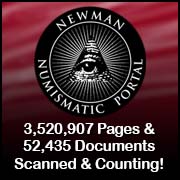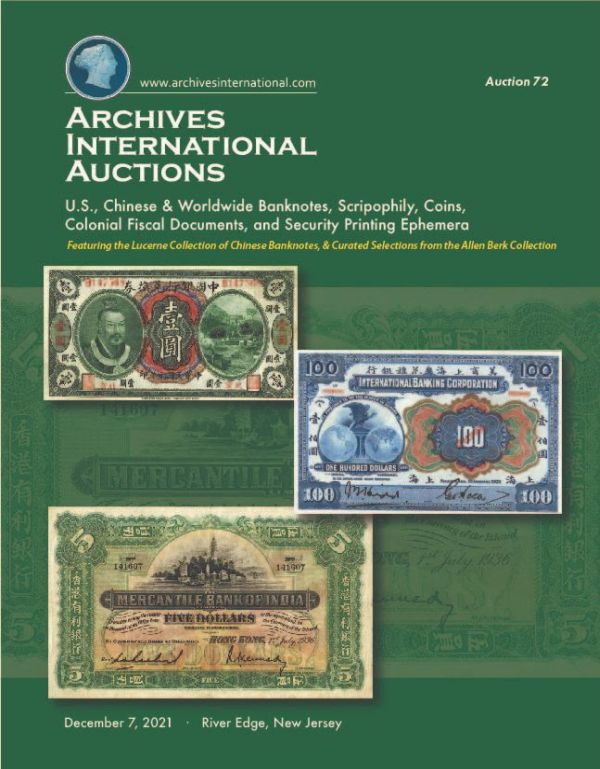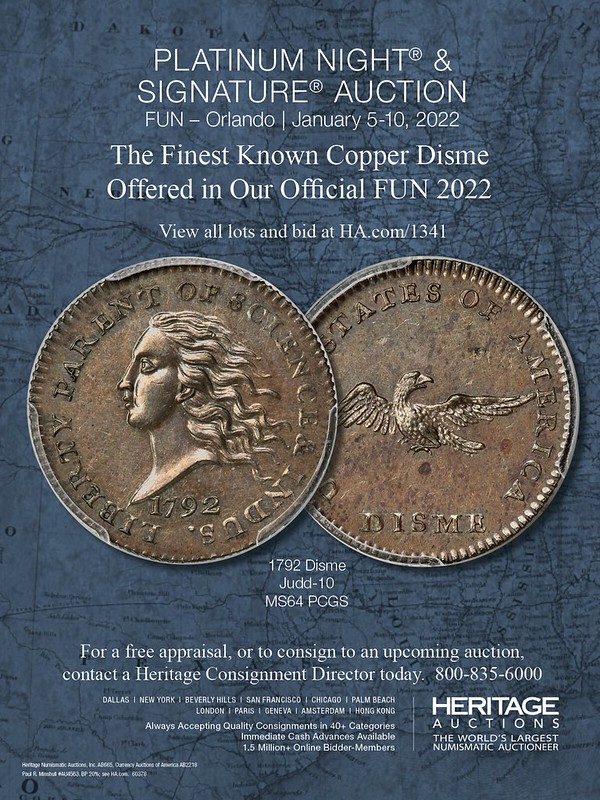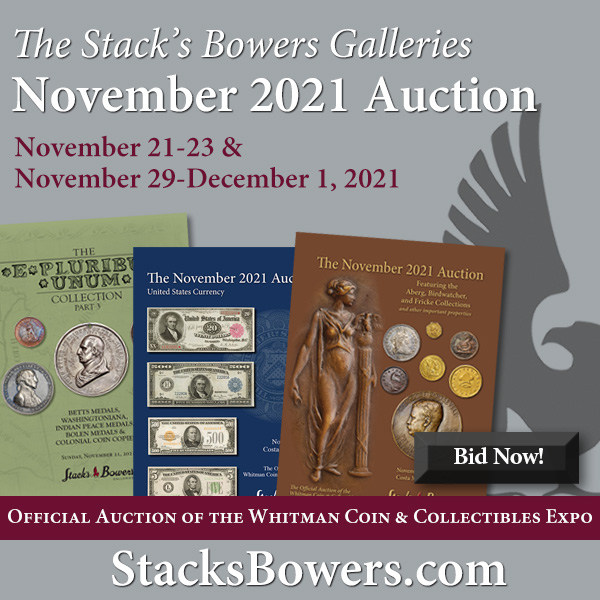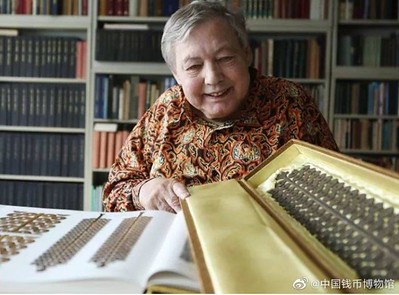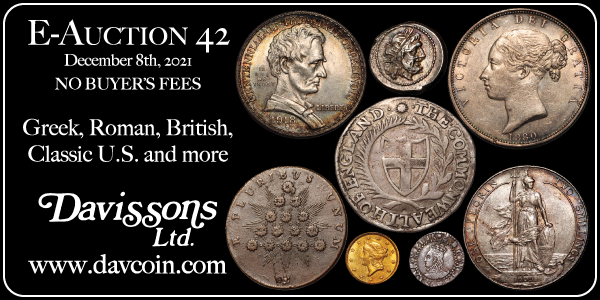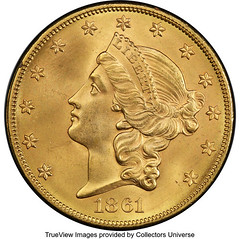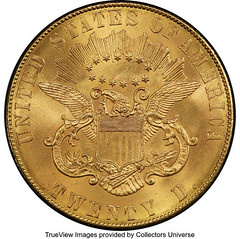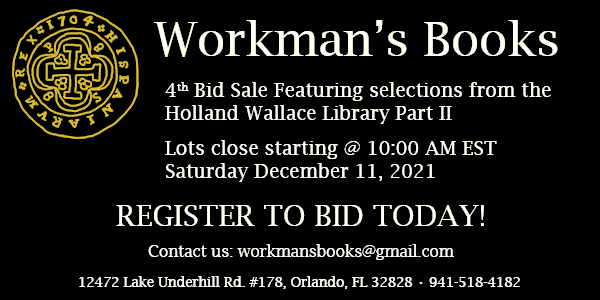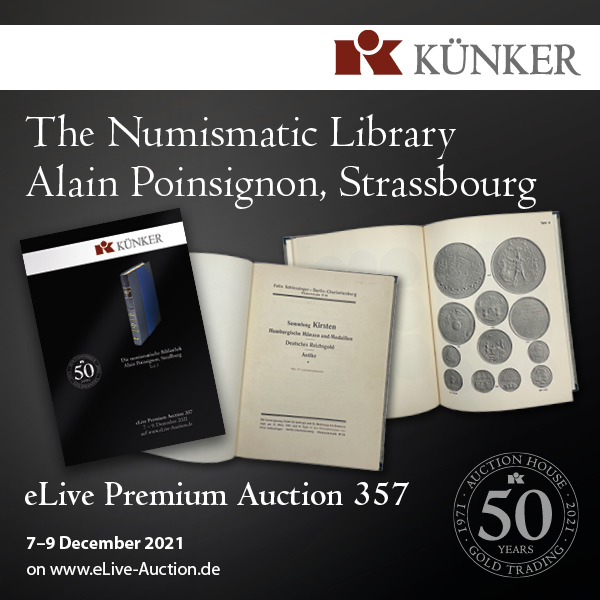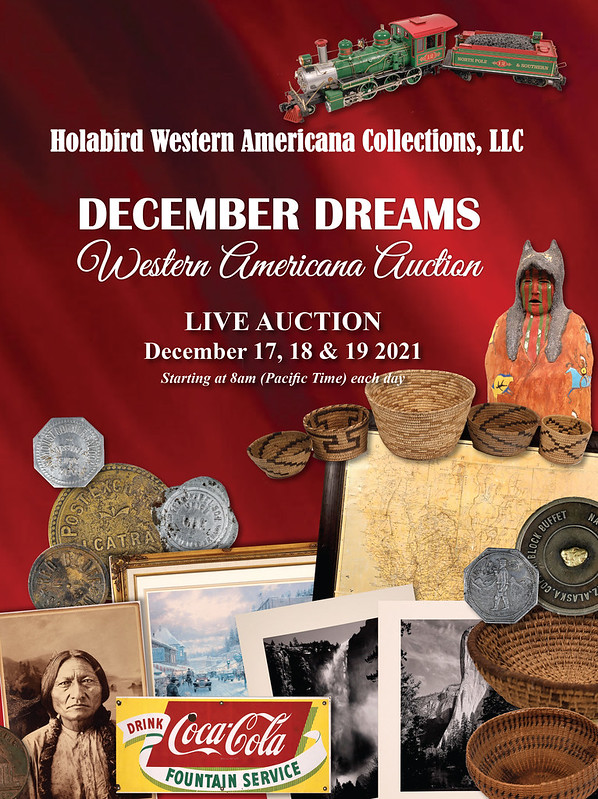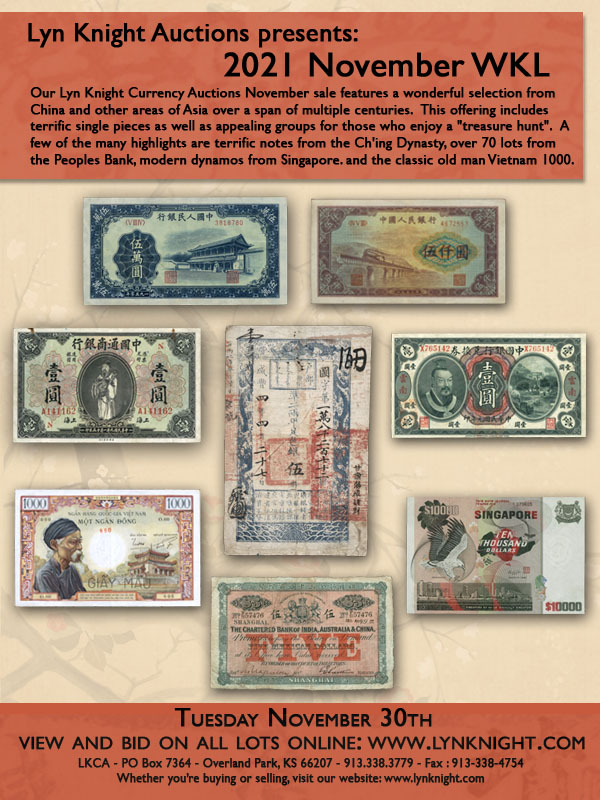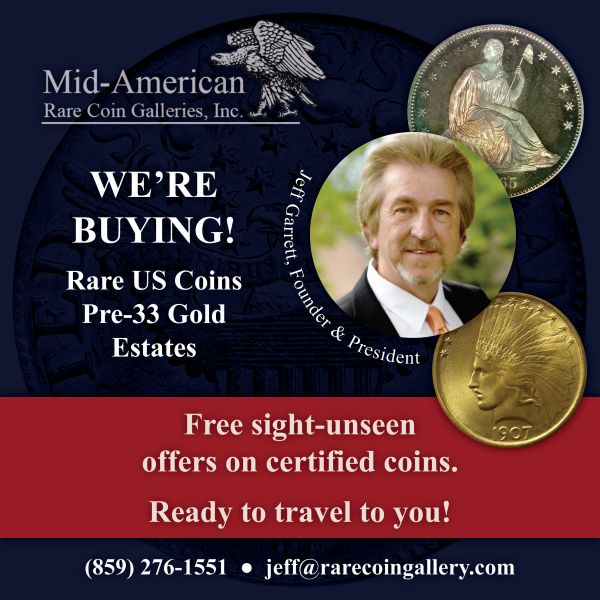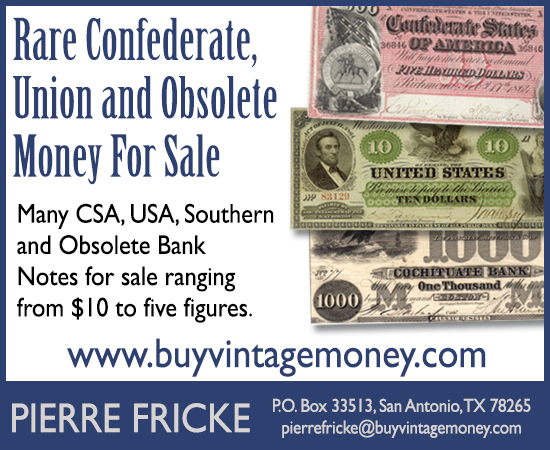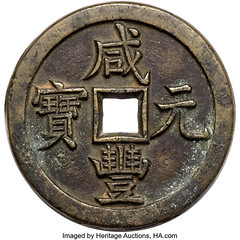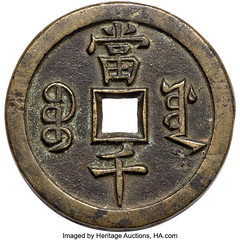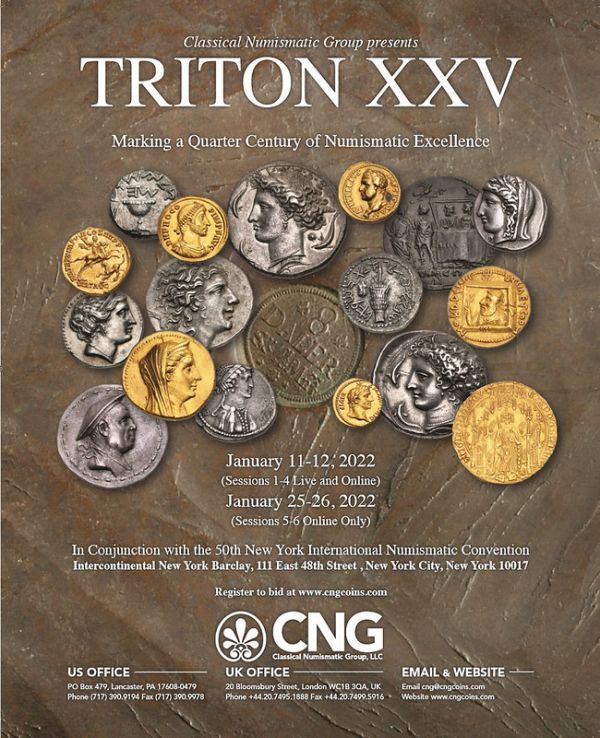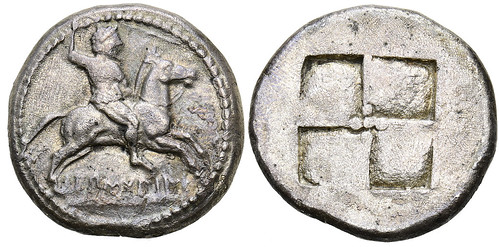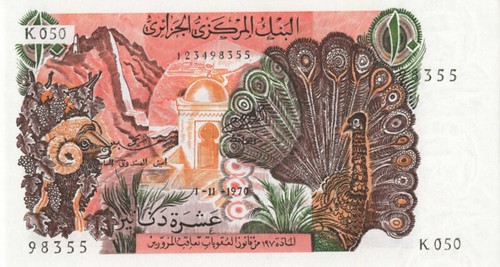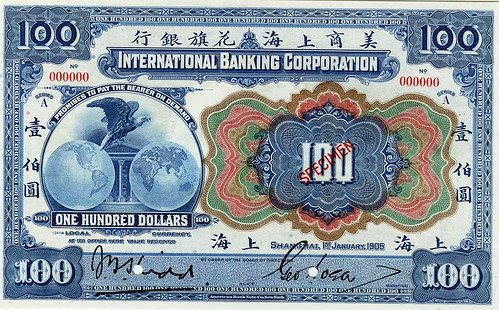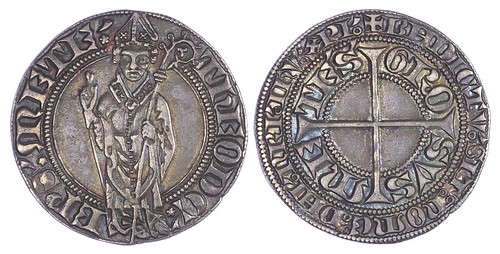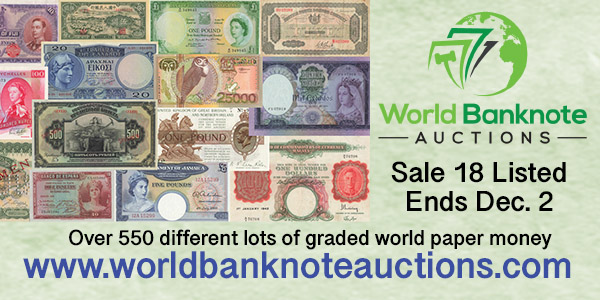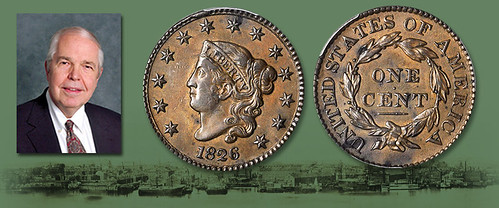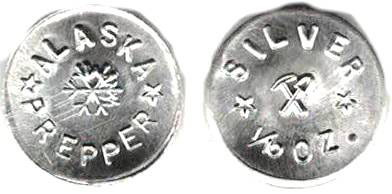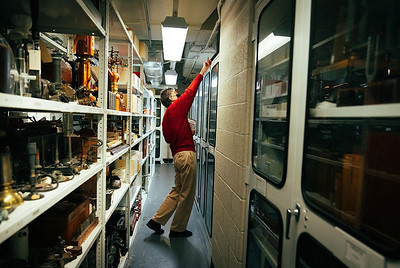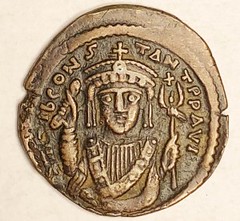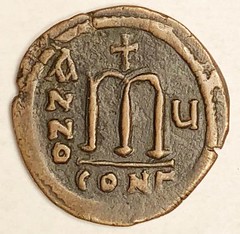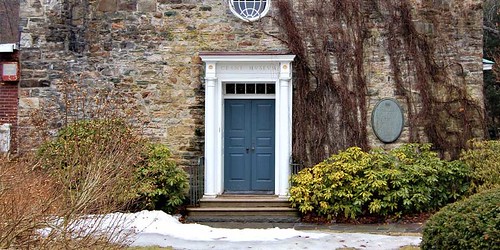
Visit our NBS Sponsors


About UsThe Numismatic Bibliomania Society is a non-profit association devoted to the study and enjoyment of numismatic literature. For more information please see our web site at coinbooks.org SubscriptionsThose wishing to become new E-Sylum subscribers (or wishing to Unsubscribe) can go to the following web page link MembershipThere is a membership application available on the web site Membership Application To join, print the application and return it with your check to the address printed on the application. Print/Digital membership is $40 to addresses in the U.S., and $60 elsewhere. A digital-only membership is available for $25. For those without web access, write to: Charles Heck, Treasurer
AsylumFor Asylum mailing address changes and other membership questions, contact Chuck at this email address: treasurer@coinbooks.org SubmissionsTo submit items for publication in The E-Sylum, write to the Editor at this address: whomren@gmail.com BUY THE BOOK BEFORE THE COINSale CalendarWatch here for updates! |
- WAYNE'S WORDS: THE E-SYLUM NOVEMBER 28, 2021
- ASYLUM WINTER 2021 ISSUE PUBLISHED
- KOLBE & FANNING ACCEPTING POINSIGNON BIDS
- POINSIGNON LIBRARY, INTERNATIONAL COIN TRADE
- ANS ANNOUNCES PRINT-ON-DEMAND PROGRAM
- NEW BOOK: COMMEMORATIONS OF WASHINGTON
- NEW BOOK: FAUSTINA THE YOUNGER
- NEW BOOK: THE WINCHESTER MINT REPRINT
- ONLINE RESOURCES FOR ANCIENT COINS
- WERNER BURGER (1936-2021)
- CHARLES BARBER LETTER ON ANTHONY PAQUET DIES
- NNP SEEKS LIBRARY TECHNICAL ASSISTANT
- MORE ON HOLLAND WALLACE
- NOTES FROM E-SYLUM READERS: NOVEMBER 28, 2021
- ANS 2022 NUMISMATIC CONGRESS TRAVEL GRANTS
- STACK'S BOWERS PHILADELPHIA GALLERY OPENS
- VOCABULARY TERM: GERMAN-SILVER
- ROBERT LYNN HENDERSHOTT (1898-2005)
- WILLIAM WELLS BROWN, WILDCAT BANKER?
- MORE NEW COIN DESIGN IDEAS
- DAVISSON'S E-AUCTION 42 ANCIENTS
- HERITAGE DECEMBER 2021 HONG KONG SALE
- SELECTIONS FROM KüNKER ELIVE AUCTION 69
- WORLD BANKNOTE AUCTIONS SALE 18 SELECTIONS
- ARCHIVES INTERNATIONAL AUCTION 72 SELECTIONS
- NUMISMATIC NUGGETS: NOVEMBER 28, 2021
- GIRL FINDS 2ND YEAR SILVER SHEKEL IN JERUSALEM
- AARON OPPENHEIM, ARCHEOLOGIST
- PIGGYBANK FULL OF 1826 LARGE CENTS
- ALASKA PREPPER TOKENS
- WHAT IS A MODERN COIN?
- FLOODING THREATENS SMITHSONIAN
- LOOSE CHANGE: NOVEMBER 28, 2021
- FEATURED WEB SITE: CRANE MUSEUM OF PAPERMAKING
Click here to read the thin version on the web
Click here to subscribe
Click here to access the complete archive
To comment or submit articles, reply to whomren@gmail.com
Content presented in The E-Sylum is not necessarily researched or independently fact-checked, and views expressed do not necessarily represent those of the Numismatic Bibliomania Society.
WAYNE'S WORDS: THE E-SYLUM NOVEMBER 28, 2021
 We now have 6,722 subscribers. No new
subscribers this week.
We now have 6,722 subscribers. No new
subscribers this week.
Thank you for reading The E-Sylum. If you enjoy it, please send me the email addresses of friends you think may enjoy it as well and I'll send them a subscription. Contact me at whomren@gmail.com anytime regarding your subscription, or questions, comments or suggestions about our content.
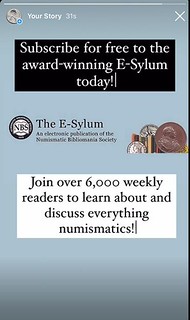 Thanks to Kellen Hoard for promoting us with
a Story on his Instagram account. Thanks also to Martin Kaplan for suggesting it!
Thanks to Kellen Hoard for promoting us with
a Story on his Instagram account. Thanks also to Martin Kaplan for suggesting it!
This week we open with a new issue of our print publication, updates on the Poinsignon library sale, three new books, online sources for ancient coin research, updates from the Newman Numismatic Portal, and more.
Other topics this week include the Winchester Mint, Werner Burger, Charles Barber, Anthony Paquet, Holland Wallace, Bob Hendershott, the 2022 Warsaw Numismatic Congress, German silver, wildcat banking, new coin design ideas, LOTS of auction previews, a 2nd year silver shekel, 1826 Large Cents, Alaska prepper tokens, and the Crane Museum of Papermaking.
To learn more about the international coin trade, Faustina the Younger, Wildwinds, Miquel Pratt, William Wells Brown, ANS Travel Grants, Mother coins, world banknotes, the 1907 Brenner Lincoln plaque, ultra-modern coins, psychophysics in numismatics and the man-headed bull, read on. Have a great week, everyone!
Wayne Homren
Editor, The E-Sylum
THE BOOK BAZARRE
ASYLUM WINTER 2021 ISSUE PUBLISHED
The Winter 2021 issue of The Asylum is on the way from our sponsor, the Numismatic Bibliomania Society. Maria Fanning edits our print journal, and she submitted this report. -Editor
The Asylum Winter Issue
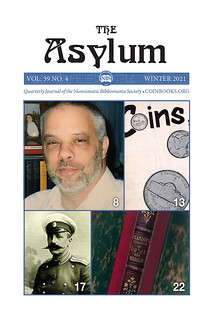 The Asylum's Winter 2021 issue is on
its way to NBS members. In this issue, we grieve the loss of Tom Fort with an obituary by Pete Smith, a bibliography compiled by David Fanning, and
remembrances by NBS members and friends.
The Asylum's Winter 2021 issue is on
its way to NBS members. In this issue, we grieve the loss of Tom Fort with an obituary by Pete Smith, a bibliography compiled by David Fanning, and
remembrances by NBS members and friends.
Also in this issue:
- Message from NBS President Tom Harrison
- The Origin of Coins Magazine By David W. Lange
- The Legacy of Grand Duke Georgii Mikhailovich By David F. Fanning
- ASSOCIATIONS: Autographs, Annotations, Inscriptions—Charles Ira Bushnell's Flandin's Catalogue of Coins and Medals: Part I: The Catalog and its Creator By Joel J. Orosz
KOLBE & FANNING ACCEPTING POINSIGNON BIDS
Kolbe & Fanning are accepting bids for the upcoming Künker Poinsignon Library sale. -Editor
Künker's December 7–9 Sale of the Poinsignon Library
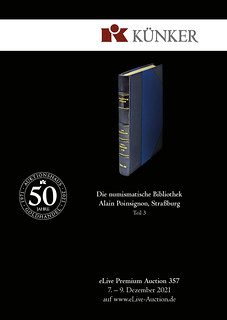 Kolbe & Fanning Numismatic Booksellers
are cooperating with Fritz Rudolf Künker, of Osnabrück, Germany, in their sale by auction of the third part of the numismatic library of
Alain Poinsignon of Strasbourg. This 1970-lot sale is devoted exclusively to numismatic sale catalogues, and constitutes one of the truly great
offerings of these important research tools. The eLive Premium Auction will be held on December 7–9, 2021, and the 497-page PDF catalogue can be
downloaded here.
Kolbe & Fanning Numismatic Booksellers
are cooperating with Fritz Rudolf Künker, of Osnabrück, Germany, in their sale by auction of the third part of the numismatic library of
Alain Poinsignon of Strasbourg. This 1970-lot sale is devoted exclusively to numismatic sale catalogues, and constitutes one of the truly great
offerings of these important research tools. The eLive Premium Auction will be held on December 7–9, 2021, and the 497-page PDF catalogue can be
downloaded here.
Kolbe & Fanning clients who wish to participate in the Poinsignon sale are invited to place their bids through us at no additional charge. We will be participating throughout the entire three-day sale and will handle bidding for our clients as well as for ourselves. The buyer's premium of 20% will be the same for bidders participating through Kolbe & Fanning as it is for those participating directly through Künker. Any items purchased by us on behalf of clients will be sent to us in Ohio and forwarded from our office. This will allow Kolbe & Fanning clients to take advantage of lower international shipping costs and simplified customs clearance.
POINSIGNON LIBRARY, INTERNATIONAL COIN TRADE
Künker submitted this press release regarding their upcoming sale of part 3 of the Alain Poinsignon Library. -Editor
Historical Testimonies of the International Coin Trade at Künker
From 7 to 9 December 2021, part 3 of the Alain Poinsignon Library will be on offer. It contains almost 2,000 lots with historical auction catalogs. You will find all the big names of the numismatic world: from Adolph E. Cahn to L. & L. Hamburger and Felix Schlessinger, from Henri Rolland in Paris and Jacques Schulman in Amsterdam to Sotheby, Wilkinson and Hodge in London.
ANS ANNOUNCES PRINT-ON-DEMAND PROGRAM
In a November 24, 2021 email to its membership, the American Numismatic Society announced a new print-on-demand program for numismatic literature. -Editor
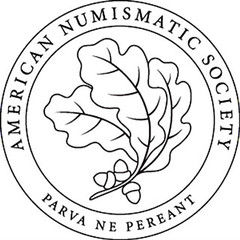 Every month the ANS will release 4–10
out-of-print and new titles as official POD editions, from recent monographs to the earliest numbers from series such as Numismatic Studies
and Numismatic Notes and Monographs.
Every month the ANS will release 4–10
out-of-print and new titles as official POD editions, from recent monographs to the earliest numbers from series such as Numismatic Studies
and Numismatic Notes and Monographs.
Why print-on-demand?
Many popular ANS titles are now out-of-print. POD rescues these and offers affordable, high-quality editions using the original design and images
from the first printing.
Our print-on-demand books and journal issues are officially branded by the ANS at prices often significantly lower than the resale market.
On occasion, new ANS books will be published directly as POD saving readers time and money in receiving new volumes.
NEW BOOK: COMMEMORATIONS OF WASHINGTON
The late Syd Martin was not only a Board Member of the Numismatic Bibliomania Society and author of multiple award-winning landmark books on U.S. colonial numismatics, he was also an avid collector and student of numismatic souvenirs of the 1932 bicentennial of George Washington's birth. He tracked these items relentlessly, scouring flea markets and online listings alike with the same gusto he held for locating rare varieties and previously unpublished information about colonial coinage. Like all his other books, Syd's catalog is long-awaited and sure to become the standard reference for the field. -Editor
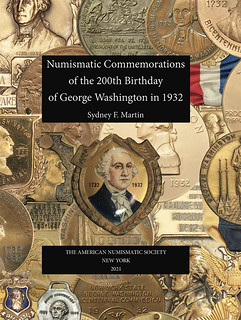 Numismatic Commemorations of the 200th
Birthday of George Washington in 1932
Numismatic Commemorations of the 200th
Birthday of George Washington in 1932
by Sydney F. Martin
Hardcover ISBN 978-0-89722-371-3
Paperback ISBN 978-0-89722-378-2
600 pp., full-color figs. throughout
HARDCOVER
Retail Price: $150 + s/h
Member Price: $105 +s/h
PAPERBACK
Retail Price: $100 + s/h
Member Price: $70 +s/h
NEW BOOK: FAUSTINA THE YOUNGER
The second new ANS book is Martin Beckmann's work on the coinage of Faustina the Younger. -Editor
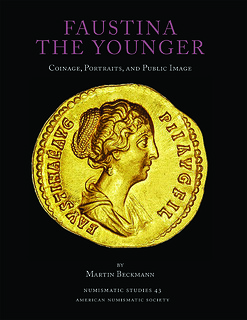 Faustina the Younger
Faustina the Younger
(Numismatic Studies 43)
by Martin Beckmann
Retail price: $70 plus shipping & handling
ANS Member price: $49 plus shipping & handling
ISSN 0517-404X
Hardcover ISBN 978-0-89722-366-9
vii + 175 text pages, color and b/w figs., 30 color plates
NEW BOOK: THE WINCHESTER MINT REPRINT
Ted Banning passed along this news of a coming reprint of the 2012 Martin Biddle catalogue of the known coins of the Winchester Mint. Thanks. -Editor
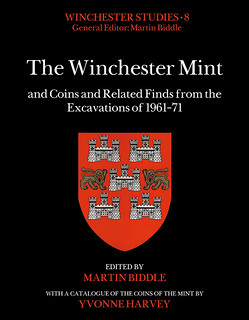 FORTHCOMING (REPRINT AND OPEN ACCESS)
FORTHCOMING (REPRINT AND OPEN ACCESS)
The Winchester Mint and Coins and Related Finds from the Excavations of 1961–71
edited by Martin Biddle. Hardback; 215x276mm; 768pp. Print RRP: £115.00 (eBook to be Open Access). 781 2021 Winchester Studies 8. ISBN
9781803270128.
Winchester Studies 8: Edited by Martin Biddle with a catalogue of the known coins of the mint by Yvonne Harvey, this volume records and illustrates the minting of silver pennies in Winchester between the reigns of Alfred the Great and Henry III, a period of three and a half centuries. At the Mint, which was situated in the area of the High Street to the east of where the city's cross now stands, at least 24 million silver pennies (possibly as many as 50 million) were struck. Five and a half thousand survive in museums and collections all over the world. These have been sought out and photographed (some 3200 coins in 6400 images detailing both sides), and minutely catalogued by Yvonne Harvey for this volume.
ONLINE RESOURCES FOR ANCIENT COINS
The latest article in the CoinWeek Ancient Coin Series by Mike Markowitz discusses several online resources for researching ancient coins. These are all great picks, and many are useful for other numismatic specialties as well. We've covered many of these before in The E-Sylum, but this is a great one-stop reference. Here's an excerpt - be sure to read (and bookmark) the complete article online. -Editor
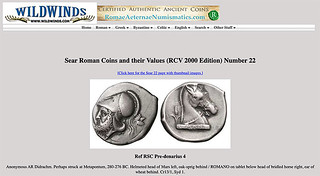 For many collectors of classic and modern
American coins, the only information resource they need is the old, reliable
For many collectors of classic and modern
American coins, the only information resource they need is the old, reliable Red Book
, which will mark its 75th anniversary in 2022.
Collectors of ancient coins, however, face a problem that is considerably more complex. With thousands of types issued by hundreds of cities,
states, and rulers over many centuries, information on ancient coins is scattered across out-of-print books and obscure journal articles in many
languages. A common saying among old-school collectors is buy the book before you buy the coin
– but finding these books often requires
diligent, patient search, and buying them may demand deep pockets.
WERNER BURGER (1936-2021)
In her latest Chinese Money Matters blog, Helen Wang of the British Museum published an obituary of Hong Kong numismatist Dr. Werner Burger. -Editor
Werner Burger (Chinese: 布威纳 Bu Weina) was born in Munich in 1936. He studied Chinese at Ludwig Maximilian University of Munich (LMU), graduating in 1962, with a thesis on Chinese money. According to an announcement by the Chinese Numismatic Museum in Beijing, Burger took 16 years to complete his PhD (instead of the usual 3-4 years), and 30 years to complete his volume Ch'ing Cash (2016).
CHARLES BARBER LETTER ON ANTHONY PAQUET DIES
A recent addition to the Newman Numismatic Portal is a letter from Charles Barber letter about Anthony Paquet coin dies. Project Coordinator Len Augsburger provided the following report. Thanks. -Editor
Anthony Paquet Dies
Anthony C. Paquet was Assistant Engraver of the U.S. Mint from 1857 to 1864 and engraved approximately 30 medals in the U.S. Mint medal series (catalogued by Julian), in addition to working on federal coinage. Paquet's 1861 $20 double eagle is a legendary U.S. rarity, with an example recently sold by Heritage at this year's ANA Convention for $7.2 million.
The Paquet family evidently left certain dies behind, and Charles Barber wrote to Philadelphia Mint Superintendent A. Loudon Snowden on August 27,
1883, I have examined the dies left here by the Paquet family, and respectfully report that I consider them valueless. In the case of the Trade
Dollar, we have the hubs made from these dies. Therefore can make any number required. The others are old experimental dies and therefore of no value
now.
Whether the old experimental dies
included the famous tall letters
1861 $20 reverse die is a matter for conjecture, but what is
certain is that today's collectors would place for more value on the Paquet dies than did the engraver Charles Barber.
Image: 1861 $20 Pacquet MS67 PCGS CAC, ex. Heritage Auctions ANA 8/2020, lot 3471, realized $7.2 million, images courtesy of Heritage Auctions.
Link to Charles Barber letter on Newman Portal:
https://archive.org/details/paquetdiesarevalueless18830827/page/n1/mode/2up
NNP SEEKS LIBRARY TECHNICAL ASSISTANT
Newman Numismatic Portal Project Coordinator Len Augsburger provided this announcement of an job opening. -Editor
Newman Portal is seeking a full-time library technical assistant to help continue the growth of this online resource. This position is based at Washington University in St. Louis, with duties as follows:
MORE ON HOLLAND WALLACE
Dave Lange submitted these notes on Holland Wallace. Thanks! -Editor
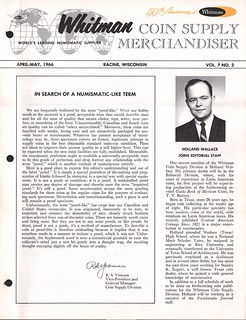 I noticed that the numismatic library of
Holland Wallace is coming up for sale. That's a name that became familiar to me while researching and writing my book on Whitman products.
I noticed that the numismatic library of
Holland Wallace is coming up for sale. That's a name that became familiar to me while researching and writing my book on Whitman products.
Wallace joined the company in 1966 and was with it for several years. He was a specialist in the numismatics of Latin America and contributed to both Whitman's world books and its monthly periodical, The Whitman Numismatic Journal. I see from the auction catalog that he also published his own lists of world coins starting 1976. Ken Bressett undoubtedly could tell readers much more.
I'm attaching the front page of the April-May 1966 issue of Whitman Coin Supply Merchandiser, a publication for the company's jobbers and coin dealers. I used this periodical extensively in researching my book, and it includes an announcement of Holland's hiring.
NOTES FROM E-SYLUM READERS: NOVEMBER 28, 2021
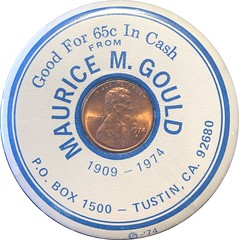 Collecting Numismatic Advertising
Mirrors
Collecting Numismatic Advertising
Mirrors
Cole Hendrickson writes:
"Regarding Pete Smith's article in the recent E-Sylum, I thought I would chime in to say that he is not the only person interested in numismatic advertising mirrors! While I don't quite have a collection of them, I do have one example which is a Maurice M. Gould advertising mirror with an encased 1974-D cent. As Pete mentioned in the article, they are an interesting area of numismatic history that brings to light numismatic individuals who might otherwise be forgotten."
Thanks! Glad to hear it! Interesting piece - kind of a combination mirror / encased cent. Nice. -Editor
Pete Smith adds:
"The Gould mirror is also a "Good For" trade mirror. That gives it a link to trade mirrors from the 1890's."
To read the earlier E-Sylum article, see:
ROBERT ARTHUR JOSLIN, SR. (1935-2005)
(https://www.coinbooks.org/v24/esylum_v24n47a16.html)
Other topics this week include the world's oldest mint, Miquel Pratt, Rembrandt, and Global Certification Services sample slabs. -Editor
ANS 2022 NUMISMATIC CONGRESS TRAVEL GRANTS
The American Numismatic Society is making available travel grants to the 2022 International Numismatic Conference in Warsaw. -Editor
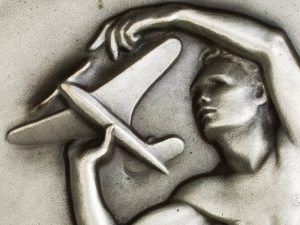 The American Numismatic Society (ANS)
announces that it will make travel grants available for attendees of the XVIth International Numismatic Congress who would be unable to attend
otherwise. The ANS will award these grants to up to eight eligible applicants.
The American Numismatic Society (ANS)
announces that it will make travel grants available for attendees of the XVIth International Numismatic Congress who would be unable to attend
otherwise. The ANS will award these grants to up to eight eligible applicants.
The International Numismatic Congress is convened every six years as a regular assembly of numismatic scholars, curators, and researchers and consists of paper and poster presentations, panels, and updates on the most current research in the field of numismatics. The XVIth Congress will be held September 11-16, 2022 in Warsaw, Poland. More information about the Congress can be found at https://inc2022.pl/.
STACK'S BOWERS PHILADELPHIA GALLERY OPENS
Stack's Bowers Galleries has opened their new location in Philadelphia. Here's their blog post. -Editor
Three weeks ago, we shared in a blog that we were nearing the completion date of our newest storefront office, this one in downtown Philadelphia. Since that blog was posted, we have completed our soft opening of the storefront and we are now accepting business. We are located at 1735 Market Street, at the corner of 18th Street and JFK Boulevard. ?
VOCABULARY TERM: GERMAN-SILVER
This week's entry from Dick Johnson's Encyclopedia of Coin and Medal Terminology is a short one on German-silver. -Editor
German-silver. A copper alloy of silver-white color because of the presence of nickel and zinc, now called nickel-silver. There is no silver in German-silver or nickel-silver. The most common formula for German-silver is 55 copper, 25 zinc, 20 nickel; the best is 46 copper, 34 zinc, 20 nickel. But the range of alloys described as German-silver is broad: 50 to 62 copper, 20 to 30 zinc, 15 to 30 nickel. In Western countries the name was dropped during World War I (for anti-German sentiment) in preference to nickel-silver.
ROBERT LYNN HENDERSHOTT (1898-2005)
American Numismatic Biographies author Pete Smith submitted this article on Bob Hendershott. Thanks! -Editor
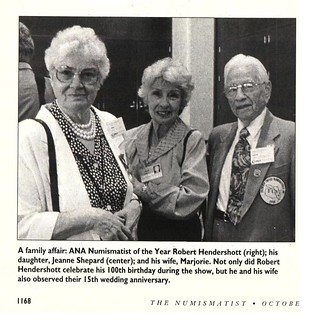 Robert Hendershott was born in the nineteenth
century and died in the twenty-first century. His birth was in St. Louis on August 7, 1898. His parents were Chalmers Doran Hendershott and Cordelia
Bartlett Hendershott. Intending a career in banking, he attended Washington University in St. Louis and the Glen City Business College at Quincy,
Illinois.
Robert Hendershott was born in the nineteenth
century and died in the twenty-first century. His birth was in St. Louis on August 7, 1898. His parents were Chalmers Doran Hendershott and Cordelia
Bartlett Hendershott. Intending a career in banking, he attended Washington University in St. Louis and the Glen City Business College at Quincy,
Illinois.
Robert married Marguerite Hamilton on June 6, 1922, and had a daughter, Jeanne. His first wife died on February 18, 1981. His second marriage was to Marjorie Owen in 1983.
WILLIAM WELLS BROWN, WILDCAT BANKER?
An article by Ross Bullen in the Public Domain Review chronicles the life of William Wells Brown and his experience issuing scrip notes in the wildcat banking era. -Editor
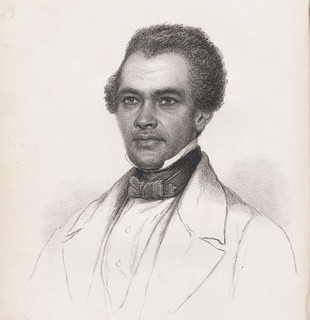 On January 1, 1834, a young man named William
escaped from slavery near Cincinnati, Ohio. Travelling at night through the frigid winter, without an overcoat to keep him warm, William suffered
from cold and hunger, and yet, as he recorded in the first of many autobiographical narratives, his thoughts were constantly drifting toward the
future.
On January 1, 1834, a young man named William
escaped from slavery near Cincinnati, Ohio. Travelling at night through the frigid winter, without an overcoat to keep him warm, William suffered
from cold and hunger, and yet, as he recorded in the first of many autobiographical narratives, his thoughts were constantly drifting toward the
future. My escape to a land of freedom now appeared certain
, he wrote, and the prospects of the future occupied a great part of my
thoughts. What should be my occupation, was a subject of much anxiety to me; and the next thing what should be my name?
Although his mother had
called him William
, he had, for most of his life, been known as Sandford
to the series of men who had legally owned him. But now he
would be William.
MORE NEW COIN DESIGN IDEAS
Wayne Pearson submitted these additional ideas for new U.S. coins . Thanks. -Editor
Here is an idea to issue three new coins to save the cent, defray the cost of printing the paper dollar bill and to raise money for the rising costs of copper and nickel in our five cent coin.
With the introduction of a two cent piece, we could cut one cent coin production in half-by making (50) one cent coins and (25) two cent coins for a total of seventy-five coins instead of one hundred. We have already saved twenty-five coin blanks.
DAVISSON'S E-AUCTION 42 ANCIENTS
In an email to clients on November 24, 2021, Lief Davisson published this overview of ancient coinage in the Davissons upcoming auction. -Editor
E-Auction 42 has just two weeks to go! Bidding closes on Wednesday, December 8th. Below we look at a few notable lots in the Greek and Roman sections.
HERITAGE DECEMBER 2021 HONG KONG SALE
In their November 18, 2021 World & Ancient Coin News email, Heritage staffers chose selected lots in the firm's upcoming December 11-13 Hong Kong International Numismatic Fair Auction. Nice picks. -Editor
SELECTIONS FROM KüNKER ELIVE AUCTION 69
Here are some items that caught my eye in the upcoming Künker eLive Auction 69. Follow the auction links and click on the images to see high resolution versions. Some really nice pieces here. I've used Google Translate for many of the descriptions. -Editor
THE BOOK BAZARRE
WORLD BANKNOTE AUCTIONS SALE 18 SELECTIONS
Here are several notes that caught my eye in the upcoming December 2, 2021 World Banknote Auctions Sale 18. -Editor
ARCHIVES INTERNATIONAL AUCTION 72 SELECTIONS
Here's a selection of items that caught my eye in the December 2021 Archives International Auction 72. -Editor
Shanghai, China, 1905. $100, P-S422s, S/M #M10-5. Blue face and back. Screaming eagle on top of 2 globes at left and in middle on back, 2 printed signatures. Specimen banknote. Red specimen overprint, Ò00000Ó serial numbers and POC's. PMG graded Gem uncirculated 65 EPQ condition. A trophy for the advanced collector. ABNC.
NUMISMATIC NUGGETS: NOVEMBER 28, 2021
Here's a selection of interesting or unusual items I came across in the marketplace this week. Tell us what you think of some of these. -Editor
France, Metz, Thierry V Bayer de Boppart (1365-84), silver Gros, Thierry standing facing, raising his right hand in benediction and holding croizer in his left. Rev. Cross pattée, 3.25g (Bodeau 1641).
From Baldwin's online stock. -Editor
To read the complete lot description, see:
FRANCE, METZ, THIERRY V BAYER DE BOPPART
(1365-84), SILVER GROS (https://www.baldwin.co.uk/product/france-metz-thierry-v-bayer-de-boppart-1365-84-silver-gros/)
Other topics this week include a G.A.R. medal, the 1907 Brenner Lincoln plaque, and a ten dollar bill with the signatures of seven U.S. Presidents. -Editor
GIRL FINDS 2ND YEAR SILVER SHEKEL IN JERUSALEM
Arthur Shippee and Aaron Oppenheim passed along stories of a girl's find in Jerusalem. Thanks! -Editor
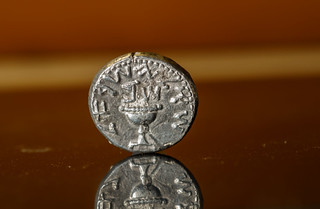 A rare silver coin from the first century was
found by an 11-year-old girl volunteering in an archaeological project, the Antiquities Authority (IAA) announced on Tuesday. The coin was likely
minted by a priest who joined the Jewish rebels against the Romans, which would make it one of the very few remains coming directly from the
Temple.
A rare silver coin from the first century was
found by an 11-year-old girl volunteering in an archaeological project, the Antiquities Authority (IAA) announced on Tuesday. The coin was likely
minted by a priest who joined the Jewish rebels against the Romans, which would make it one of the very few remains coming directly from the
Temple.
This is a rare find, since out of many thousands of coins discovered to date in archaeological excavations, only about 30 are coins made of
silver from the period of the Great Revolt,
said Dr. Robert Kool, head of the Coin Department at the IAA.
AARON OPPENHEIM, ARCHEOLOGIST
Aaron Oppenheim added this personal note about archeology in Israel. Thanks! Great photos. -Editor
On my visit to Israel in February 2020, I went to a location where such archeological activity is conducted and participated in the process. Here's a recap of the process from some pictures
PIGGYBANK FULL OF 1826 LARGE CENTS
In his Stack's Bowers blog Dave Bowers published an interesting article about Oscar Schilke's find of a Boston cache of Large Cents of a single date. -Editor
The late Oscar G. Schilke lived on the shore of Dodge Pond in Niantic, Connecticut, in the 1950s and 1960s. Prominent on the numismatic scene for many years beginning in the early 1930s, he would often set up exhibits in banks. These displays served to attract customers to the financial institutions, and for Oscar, it meant getting leads which often resulted in his acquiring choice pieces for his collection.?
On one particular day a gentleman told him that in the course of doing some work in the Boston harbor area, he came across what was left of an old building which was once the office of a customs agent or toll-taker of some kind—the informant was not sure. In any event, cemented into the floor of the structure was a little metal vault or strong box which, through an opening, appeared to contain a bunch of old coins.?
ALASKA PREPPER TOKENS
Dick Hanscom edits the Alaskan Token Collector & Polar Numismatist, an excellent publication. The November/December 2021 issue includes a nice article about tokens Dick made for his friend Rudy, the "Alaska Prepper".
There are many views and definitions of the terms "survivalist" and "prepper". Both like to be prepared for unforeseen future events, learning useful skills and stocking up on all manner of foodstuffs and supplies. Extreme survivalists build bunkers and stock ammunition for the apocalypse, but also plan for evacuation and life on the move. Preppers are closer to the mainstream, planning to ride out difficulties in place (but with go-bags packed and ready just in case). My mother was the Depression-child version of a prepper before the word was invented, stockpiling dozens of cans of every favorite soup or side dish so as never to run out. I envy the experienced prepper - we've never been that organized. But I guess I'll have enough coin books to read if I don't break my glasses fighting off zombies.
Anyway, with permission we're republishing the complete article here. Many thanks to Dick for providing the text and images. -Editor
ALASKA PREPPER/NUTRIENT SURVIVAL
As you read in the April issue, Rudy, the Alaska Prepper, gifted me one ounce of silver. So, in return, I gifted him ten 1/10 oz. silver Alaska Prepper tokens. I created a monster! He liked them so much he ordered 100. And then 100 more.
WHAT IS A MODERN COIN?
Here are a couple of items relating to modern coinage. The first is an article on Cosmos of Collectibles by Daniel Baumbach titled "What Is the Difference Between a Coin, a Commemorative Coin and a Medal?" The second item is a CoinWeek podcast interview with representatives from CIT, maker of a plethora of modern medallic issues using advanced minting techniques. -Editor
What Is the Difference?
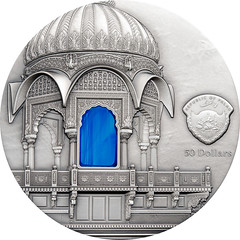 Structuring the world of modern coins isn't
that easy. Just some of the items laymen classify as coins are actually coins. In addition, there are special and hybrid forms and all kinds of
unclear terms such as commemorative coin, collector coin, NCLT, bullion coin etc. Which types of coins exist? We present an overview.
Structuring the world of modern coins isn't
that easy. Just some of the items laymen classify as coins are actually coins. In addition, there are special and hybrid forms and all kinds of
unclear terms such as commemorative coin, collector coin, NCLT, bullion coin etc. Which types of coins exist? We present an overview.
Let's start with the typical form of a coin: circulation coins are coins issued by a state. They are legal tender with a face value and usually
feature the name or the symbol of the issuing nation, for example the portrait of the monarch. They circulate as genuine
coins in the
respective issuing country or monetary union and can be used to pay at any time without a problem – provided that they aren't old coins that lost
their status as legal tender.
FLOODING THREATENS SMITHSONIAN
Len Augsburger passed along this scary New York Times story about the rising threat of flooding at the Smithsonian museums in Washington, D.C. He notes: "Most of the National Numismatic Collection is on the fourth floor of the National Museum of American History in the curatorial area. The public exhibit is on the first floor." See the full article online for some great photos. -Editor
President Warren Harding's blue silk pajamas. Muhammad Ali's boxing gloves. The Star-Spangled Banner. Scripts from the television show "M*A*S*H."
Nearly 2 million irreplaceable artifacts that tell the American story are housed in the National Museum of American History, part of the Smithsonian Institution, the biggest museum complex in the world.
Now, because of climate change, the Smithsonian stands out for another reason: Its cherished buildings are extremely vulnerable to flooding, and some could eventually be underwater.
LOOSE CHANGE: NOVEMBER 28, 2021
Here are some additional items in the media this week that may be of interest. -Editor
Dealer Frank Robinson attended the recent Baltimore Expo and wrote about his experience, including this nice acquisition. -Editor
... a dollar-sized Byzantine bronze of Emperor Tiberius Constantine (578-82 AD). The big M signifies the denomination (follis); the u
the
regnal year (fifth). CON is the mint, Constantinople; the Gamma after it, the officina
or division in the mint. It was $200, actually the most
I ever paid for a Byzantine bronze; but the quality is great. I was very glad to get it.
Quality is the name of the game.
To read the complete article, see:
Baltimore Coin Show Fun
(https://rationaloptimist.wordpress.com/2021/11/22/baltimore-coin-show-fun/)
Other topics this week include the origins of money, and the man-headed bull. -Editor
FEATURED WEB SITE: CRANE MUSEUM OF PAPERMAKING
This week's Featured Web Site is the Crane Museum of Papermaking. Found via News & Notes published by the Society of Paper Money Collectors (Volume VII, Number 23, November 23, 2021).
The Crane Museum of Papermaking is located in what was the rag room of Crane's Old Stone Mill, dating back to 1844. This was the first mill built by the second generation of Crane papermakers in Dalton, Mass.— Zenas Marshall and James Brewer Crane, following the retirement of the pioneer papermaker Zenas Crane.
The Museum opened in 1930 after an extensive renovation, making it one of the oldest corporate museums in the country. The grounds were designed by the F.L and J.C Olmsted firm. Exhibits in the Museum trace the 250-year history of Crane papermaking from The Liberty Paper Mill in Milton, Mass., which operated from 1770 to 1793, to the present. The Liberty Mill was indeed a cradle of the American Revolution, serving such revolutionary luminaries as Paul Revere, Henry Knox, John Hancock and a host of others responsible for today's freedom.

